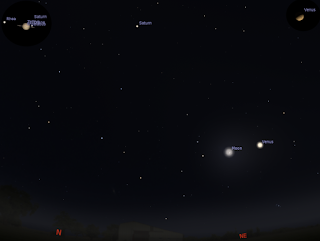The New Moon is Wednesday June 25. Earth is at solstice on the 21st. Mercury is rising the evening twilight. Mars is lowering in the
early evening sky as it moves through Leo moving away from the bright star Regulus. Saturn and Venus are visible in the morning twilight. The Moon is close to Venus on the 22nd. Look for the constellation Corona Borealis before midnight, the blaze star T Coronae Borealis (TCrB) may go Nova eventually.
The New Moon is Wednesday June 25. the Moon is at Perigee, when it is closest to the Earth, on the 23rd. Earth is at solstice on the 21st, when the day is shortest.

Eastern twilight sky on the morning of Sunday, June 22 as seen from Adelaide
at 05:53 ACST (90 minutes before sunrise, click to embiggen).
Venus is visible close to the thin crescent Moon in the twilight below Saturn.
The insets show the telescopic views of Saturn and Venus at this time.
Similar views will be seen from the rest of Australia at roughly the equivalent local time (90 minutes before sunrise).

Northern sky on the evening of Saturday, June 21 as seen from Adelaide at 22:00 ACST (click to embiggen)
If you look to the North just before midnight, you will see a prominent bright orange star, Arcturus, if you look northeast you will see a dainty circlet of stars. Corona Borealis, the northern crown. The blaze star T CrB is located on the right-hand side to the circlet, where the line of stars turns down, there are no other bright stars in the region, so when it erupts it will be easily visible. Viewing tips at my T CrB post. After some brief excitement last week (false alarm) TCrB can potentially go Nova any time between now and August 2025.
Similar views will be seen from the rest of Australia at roughly the equivalent local time.

North-western
sky on Saturday, June 21 as seen from Adelaide at 18:42 ACST (90
minutes after sunset, click to embiggen). Mars is drawing away from the bright star Regulus.
Similar views will be seen from the rest of Australia at roughly the equivalent local time (90 minutes after sunset).

North-western sky on Saturday, June 21 as seen from Adelaide at 18:11 ACST (60 minutes after sunset, click to embiggen). Mercury is climbing higher into the twilight and is now easily visible.
Similar views will be seen from the rest of Australia at roughly the equivalent local time (60 minutes after sunset).

Whole sky on Saturday, June 21 as seen from Adelaide at 18:42 ACST, 90 minutes after sunset (click
to embiggen). Mars is in the north.
Bright Sirius is on the north-west horizon as Scorpius climbs higher in the east.
The Southern Cross is rising in the Southern sky. The moon is waning and the fainter clusters and nebula are becoming easier to see.
Elsewhere
in Australia will see a similar view at the equivalent time (90 minutes after sunset).
Mercury climbs higher in the evening twilight.
Venus is high in the morning twilight. It is below Saturn and close to the crescent Moon on the 22nd.
Mars is lowering in the evening sky and drawing way from the bright star Regulus..
Jupiter is lost in the twilight.
Saturn is rising in the morning the twilight.
Labels: weekly sky


